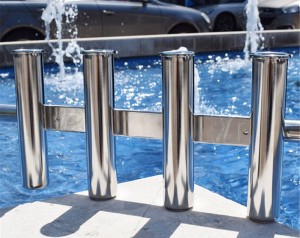Marine hardware plays a crucial role in ensuring the functionality, safety, and durability of boats and ships. From small recreational vessels to massive commercial ships, the materials used in marine hardware must be able to withstand the harsh conditions of the marine environment. In this article, we will delve into the various materials used in marine hardware, highlighting their characteristics, advantages, and applications.
Stainless Steel: The Stalwart of Marine Hardware
Stainless steel is the most widely used material in marine hardware due to its exceptional corrosion resistance properties. Its high chromium content forms a protective oxide layer, preventing rust and corrosion in saltwater environments. Stainless steel hardware is durable, strong, and can withstand extreme temperatures, making it ideal for a wide range of applications such as deck fittings, hinges, cleats, and shackles.
Bronze: A Time-Honored Choice
Bronze has been used in marine hardware for centuries, mainly because of its excellent resistance to corrosion and its ability to withstand exposure to seawater. Known for its beautiful golden hue, bronze hardware adds an aesthetic appeal to boats and ships. It is commonly used in propellers, valves, fittings, and decorative elements due to its strength, malleability, and high resistance to marine organisms.
Aluminum: Lightweight and Versatile
Aluminum is a popular choice for marine hardware where weight reduction is crucial, especially in smaller recreational boats. Its lightweight nature and corrosion resistance make it an excellent material for components like masts, cleats, and brackets. However, aluminum is more susceptible to corrosion in saltwater, so proper maintenance and protective coatings are necessary to ensure its longevity.
Nylon: The Trustworthy Synthetic
Nylon, a synthetic polymer, has gained popularity in marine hardware due to its strength, durability, and affordability. It is commonly used in components such as pulleys, blocks, and cleats. Nylon is resistant to corrosion, chemicals, and UV radiation, making it suitable for both freshwater and saltwater applications. Its low friction properties also contribute to smooth operation and reduced wear.
Fiberglass Reinforced Plastic (FRP): A Lightweight Alternative
Fiberglass-reinforced plastic, commonly known as FRP or GRP, is a composite material composed of polyester resin reinforced with glass fibers. It offers excellent strength-to-weight ratio, corrosion resistance, and versatility in molding complex shapes. FRP is widely used in marine hardware such as hatches, ladders, and bulkhead fittings. Its non-conductive nature also makes it ideal for electrical components.
Carbon Fiber: Strength and Performance
Carbon fiber is a lightweight and incredibly strong material that has found its way into high-performance marine hardware. It offers exceptional tensile strength, stiffness, and resistance to corrosion. Carbon fiber components are commonly used in racing boats, sailboat masts, and other applications where weight reduction and enhanced performance are critical factors.
Conclusion:
The selection of materials used in marine hardware is crucial for ensuring the longevity, safety, and performance of boats and ships. Stainless steel, bronze, aluminum, nylon, fiberglass reinforced plastic, and carbon fiber each offer unique characteristics and advantages. Understanding the properties of these materials allows boat owners, manufacturers, and marine enthusiasts to make informed decisions when choosing the right hardware for their vessels. By considering the specific requirements and conditions of the marine environment, one can select the most suitable materials to withstand the challenges posed by the sea.
Post time: Jul-17-2023



